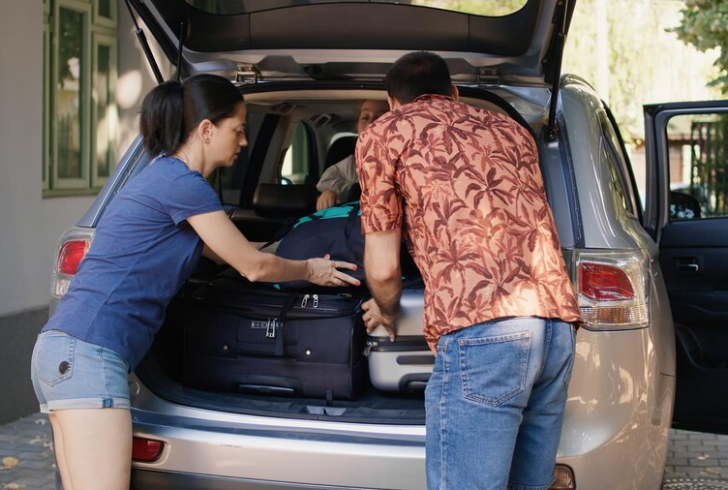Disasters can strike unexpectedly, leaving people scrambling to evacuate their homes in a hurry. Whether facing wildfires, floods, hurricanes, or other emergencies, preparing your car as a reliable defense in a disaster can make all the difference. As seen during the recent California fires, many evacuees encountered challenges like traffic jams, aimless driving, and even car trouble. With proper preparation, you can rely on your vehicle to keep you safe and ready to escape any dangerous situation.
A Safe Evacuation Depends on Preparation
When a disaster strikes, preparation often determines how smoothly evacuation proceeds. By the time evacuation orders are issued, it’s usually too late to organize and prepare a car for the journey. Regular maintenance, thoughtful packing, and having essential tools on hand give you the upper hand during emergencies.

Anyone living in areas prone to environmental disasters—such as fires, floods, blizzards, or hurricanes—should make car preparation part of their routine. A well-maintained car allows you to focus on other critical decisions during an evacuation.
Keep Your Car Fueled and Ready
Having enough fuel plays a crucial role in making your car a reliable defense in a disaster. Regardless of whether you drive a gas, hybrid, or electric vehicle, keeping your car fully fueled ensures you won’t get stranded. Gas stations rely on electricity to dispense fuel, and outages can occur during emergencies. Similarly, electric vehicles should remain charged in case power outages prevent further charging.
Electric vehicles also have an advantage in heavy traffic. Unlike gas-powered vehicles that consume fuel at any speed, electric cars regenerate their battery while braking, making them more efficient during stop-and-go traffic.
Quick Tips for Fuel Readiness:
1. Keep your gas tank at least half full during seasons prone to natural disasters.
2. Regularly charge electric vehicles when weather forecasts indicate potential emergencies.
Inspect Your Tires for Safety
Tires often go unnoticed until something goes wrong, but they take on an even more critical role during evacuations. Whether navigating through flooded streets, snowy conditions, or debris-laden roads, your tires must handle extreme environments.
Properly inflated tires with good tread improve your car’s performance and safety. Regular inspections every few months, or when refueling, can help prevent flats or blowouts when they matter most.
Tire Checklist for Emergency Preparedness:
1. Ensure tires have sufficient tread depth.
2. Confirm they are inflated to the recommended pressure.
3. Use tires appropriate for your region’s weather conditions, such as snow or all-season tires.
Clear Your Cargo Space
When disaster strikes, your car’s cargo space becomes invaluable for packing essentials. Large SUVs offer spacious storage, but even cars with smaller trunks can maximize space by folding rear seats or removing unnecessary items. Keep your vehicle free of clutter to ensure there’s room for emergency supplies.
Pack only essential items and avoid hauling non-critical belongings. Keeping your car ready to accommodate evacuation needs saves precious time when every second counts.
Equip Your Car With an Emergency Kit
An emergency preparedness kit ensures your car remains your defense in a disaster. This kit doesn’t need to take up too much space, but it should include essential tools and supplies to address common emergencies.
Must-Have Items for a Car Emergency Kit:
1. Batteries and a flashlight
2. Jumper cables
3. Bandages and a basic first-aid kit
4. Wipes, a rain poncho, and a reflective vest
5. Matches and work gloves
6. Phone charging cables and a portable power bank
In addition to these basics, tire repair tools, extra water bottles, and spare cords for electric vehicle chargers should always stay in the car. Stocking a pack of water bottles ensures you have a consistent supply of fresh water, especially during prolonged situations.
Keep a Grab-and-Go Emergency Kit Ready
While a basic car emergency kit covers everyday needs, a more extensive kit can help during prolonged disasters or evacuations. Storing these items in a go-bag or portable box ensures quick access when time is of the essence.

Items for an Extended Emergency Kit:
1. Blankets and warm clothing like hoodies
2. Shelf-stable snacks and bottled water
3. Paper maps for navigation
4. Masks and sanitizing wipes
5. USB power packs and additional phone chargers
6. A compact toolkit with pliers, screwdrivers, and duct tape
By keeping this larger kit in a convenient location, such as a closet or garage, you can easily load it into your car when needed.
Use Reliable Navigation Systems
During disasters, relying solely on phone-based navigation may not be practical. Overloaded networks, power outages, or spotty signals can render apps like Google Maps or CarPlay unreliable.
Cars with built-in navigation systems offer a dependable alternative since they store map data and operate independently of cellular networks. Many vehicles also use GPS rather than cellular service, ensuring a consistent signal. Services like OnStar or BlueLink can connect you with operators who help guide you out of dangerous areas.
Stay on Top of Car Maintenance
A poorly maintained car adds stress to an already tense evacuation. Breaking down on an evacuation route can leave you stranded or force you to abandon your vehicle. Regular maintenance helps avoid these complications, giving you peace of mind that your car can handle emergencies.
Maintenance Tips for Disaster Readiness:
1. Regularly change oil and cabin air filters.
2. Inspect brakes, belts, and hoses during routine servicing.
3. Refer to your car’s owner’s manual to follow recommended maintenance schedules.
By staying proactive with maintenance, you minimize the chances of encountering car trouble when it matters most.
Choose the Right Car for Disaster-Prone Areas
The car you drive can influence how well you handle emergencies. All-wheel-drive (AWD) vehicles, for example, provide superior traction on wet, icy, or uneven roads. In hilly regions or areas prone to flooding, AWD offers an added layer of safety compared to front-wheel or rear-wheel-drive cars.
Aside from AWD, ensure your car has features like:
1. Functional heating and air conditioning.
2. Navigation systems and driver assistance features.
3. USB ports for charging essential devices.
Cars with spacious interiors make evacuation more comfortable, especially for families or pets. If possible, opt for vehicles that balance comfort, storage, and reliability during emergencies.

